365 CONSERVING THE SIGHTHOUND
CONSERVING THE SIGHTHOUND
by David Hancock
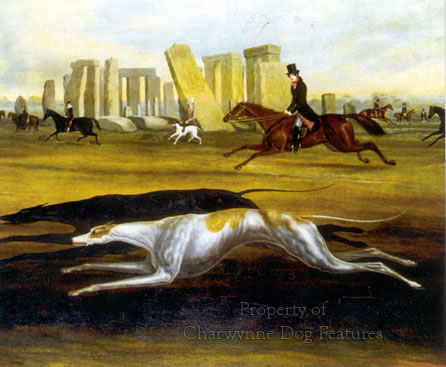 Quality of the Pursuit
Quality of the Pursuit
We have every reason to be proud of our sighthound breeds, they are a distinctive and unique part of the canine world, developed by man in the most testing terrain, the most demanding climates in the world and often against the most elusive quarry. Those hunting with dogs have great respect for their quarry, whether it’s the humble hare or the grander gazelle and this has been so throughout man’s long hunting history. Hunting with sighthounds was never about the size of the bag but about the quality of the pursuit, with the athleticism of the hounds admired no more than the agile elusiveness of their prey. Urban-dwelling town-thinking lobbyists, sadly so often with no knowledge of country people and pursuing a single agenda – the abolition of hunting with dogs, whatever the penalties to wildlife, have, like so many do-gooders, been blind to the custody of our countryside by generations of rural hound-owning sportsmen who had greater regard for conservation than they have ever been credited with.
Humane System
The widely held view that hare-coursing had the sole purpose of killing hares, rather than comparing the running and turning skills of a pursuing brace of sighthounds, soon became accepted wisdom. Pro-coursing lobbyists just couldn’t swim against the tide and the ‘antis’ exploited this quite shamelessly. The most humane system for the control of foxes shouldn’t be debased by an irrational dislike of men on horses in pink coats. If it is agreed that fox-control is essential, especially in hill areas, why not employ the soundest method of doing so? Nature is viewed by so many town-dwellers as a place where a collection of lovable animals live in harmony, whereas nature in reality is astonishingly cruel. Human ignorance about animal welfare is not bliss and no basis for activist energy. Are wild animals ever likely to benefit from innocent ignorance or from conspiring humans with a political agenda?
Maiming Foxes
Have foxes and hares benefited from such conspiracies? Or is it little to do with animal welfare when the truth is known. Sadly, maimed foxes can survive a fox-shoot. Not many hares escape a hare-shoot. A study in the May 2005 issue of Animal Welfare, the journal of UFAW, showed that up to 50% of foxes shot with shotguns were wounded not killed. I understand that in no coursing season in the last two decades of the twentieth century were more than 300 hares, of the 2,000 coursed, killed. Just under 400,000 hares were shot annually on non-coursing estates for control purposes during that time. And the hare was welcome on coursing estates. Sport is about seeking a contest not extermination; the coursing community respected hares. It is the hunter’s natural instinct to preserve what he hunts. The Veterinary Association for Wildlife Management has stated that hunting is the natural and most humane method of controlling populations of all four quarry species and is a key element in the management of British wildlife in general. That is how our sporting dogs were fashioned.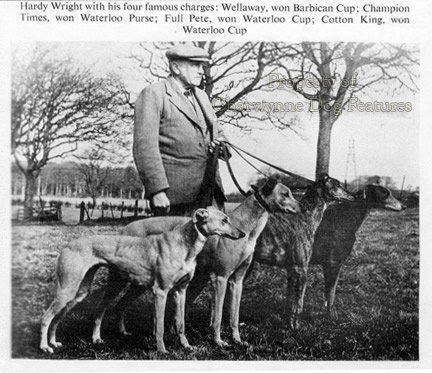
Punishing Wildlife
The management of British wildlife in general has been in the hands of countrymen throughout our history, but now, the town-dwellers are the masters, whatever the effect on our precious wildlife. Coursing is over 2,000 years old; suddenly, modern man, whilst rapidly destroying the planet, knows best. The biggest single component attending the Waterloo Cup comprised working class men from the north of England, Liverpool especially. Their elected representatives have achieved what no Danish king or Norman knight could do: deny the humble countryman his right to catch his own supper. The ban on hunting with dogs has been called an act of class war, and the class worst hit has been the working man, not the wealthy man. It takes near-genius to draft one Act which punishes both wildlife and the ordinary far-from-wealthy countryman to a greater degree than hitherto obtained in history. But by far the greatest punishment has been handed out to sporting dogs, sighthounds more than most. They have lost their reason to be, their historic role, their spiritual release, their usefulness.
Importance of Regulation
A highly-regulated country sport with very strict rules, like coursing, brings with it respect for the quarry and the country being used. As Professor Roger Scruton, writing in the Winter 2009 issue of the magazine Hunting put it: “The opponents of hunting see it as a kind of primitive battle, in which the quarry is overcome by unfair military tactics and a cruel war of attrition. For the hunt followers, however, the hunt is an equal contest, governed by rules of engagement which respect the hunted animal while giving the greatest possible scope to the hounds that are pursuing it. True, the quarry is singled out for a life and death struggle which it did nothing to provoke. But this ‘singling out’ exalts the fox or stag in the eyes of its pursuers and imposes on them the ethic of fair play.” This ‘ethic of fair play’ used to be the leitmotif of country sports and a way of bringing young adults into maturity with respect for nature and the countryside around them. The young tyro hunter off with his lurcher for a day’s sport once demonstrated the timeless trinity of man, dog and the land.
Doing Good or Not
In his masterly Rural Rites, Hunting and the Politics of Prejudice of 2006, Charlie Pye-Smith writes: “Anyone who wishes to ridicule the Act, and test it to the limits, will have no trouble doing so. Take, for example, the hunting of hares. It is illegal under the Act to hunt hares with dogs. However, you can hunt hares with as many hounds as you like providing you are pursuing hares which have been shot.” If any perverse sadist elected to maim hares with a high-powered air rifle, he could then legally course them. Is this truly how animal welfare should be enacted? Do-gooders so often end up being evil-doers. The rules of coursing did more for animal welfare than could any legal action arising from the words of this vengeful Act. Many of those opposing field sports have the strange concept of nature being left alone and being better for it. Not in 21st century over-populated Britain! Without man’s intervention, most wild creatures would starve or die of disease. Their needs rely on human control and in enlightened not prejudiced ways.
Need for a Rethink
The Hunting with Dogs Act became so closely associated with the prohibiting of fox-hunting that the ancient sport of coursing became relegated; not many sportsmen spoke up for this well-regulated sport. One hundred and forty years ago, Delabere Blaine was writing in his immense tome Rural Sports: “Coursing, like other field sportings, has its advocates and its enemies; it also presents its bright and cloudy sides. It is not, indeed, fit that we should all be enamoured of the same pursuit; but it is proper that we should not underrate the amusements followed by others.” Those who respect and practise our ancient country sports failed to close ranks when this badly-drafted bill was being framed; there should have been a realization that ‘once the pistol was loaded, it could point in any direction’. The war-poet Charles Causley once wrote a heart-rending poem about a recruiting sergeant, to the effect that ‘he’s already taken our Tommy and Kate – and he’s coming back for more’. The law concerning hunting with dogs is in a real mess; this is neither good for animal welfare nor for country sports. Before the highly vocal opponents of country sports ‘come back for more’, we, as a nation, need to put this house in order, for the sake of our wildlife just as much as for our ancient country sports. Once hunting in its widest sense is outlawed, sporting dogs become victims. There are no native sighthound breeds in mainland western Europe because coursing with dogs is banned in those countries. Yet breeds designed to conduct coursing are very popular there. Humans want the companionship of such splendid animals but not their spiritual happiness. 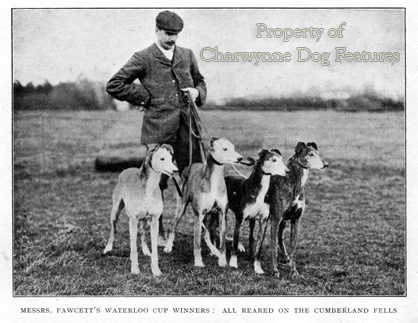
Veterinary View
The fact that the Veterinary Association for Wildlife Management has stated that hunting is the natural and most humane method of controlling populations of all four quarry species and is a key element in the management of British wildlife in general, is surely a lead for us all. The ban has affected more working class hunters than any number of men mounted and in pink coats. Look again at those depictions of the Waterloo Cup, whether on canvas or in old black and white photographs; the vast majority of the spectators wore cloth caps not top hats. They have been badly let down by those feigning to protect their interests. And so has our wildlife, if the vets are to be believed. In four successive years in the 1980s, the winners of the blue riband event of coursing, the Waterloo Cup, each won without killing a single hare between them. The coursing community had great respect for the hare, safeguarding their interests through tight regulation and being more conscious of their ultimate conservation than any urban-dwelling activist.
Lost Expertise
In many sporting dog circles, remarkable families crop up. In the coursing world, from the 1880s to the 1900s, the Wright family stands out. Edwards Clarke, the great Greyhound expert, admitted he learned most from them. Joe Wright trained the Waterloo Cup winner of 1888: Burnaby and the 1895 winner: Thoughtless Beauty. This latter final saw Joe Wright the trainer of the winner, a younger brother Tom the trainer of the runner-up, and another brother, Robert, acting as slipper for the contest. Tom trained five winners of this famous cup, for the Fawcetts and their famous ‘F&F’ kennel: Fabulous Fortune (1896), Fearless Footsteps (1900 and 1901), Farndon Ferry (1902) and Father Flint (1903), a quite stunning record for any sporting family. Farndon Ferry and another dog from the same kennel, Fiery Furnace, were considered by Edwards Clarke ‘to be the tap-roots of all Greyhounds that have either coursed or raced in the twentieth century’. Harold Wright trained Dee Rock, the Waterloo Cup winner of 1935. The Wrights, between them, possessed enormous knowledge of Greyhound training, conditioning and welfare, and especially, their health care. Will we ever see their like again? The loss of such immense expertise from the sporting dog scene, without new blood coming through, is hugely worrying.
Preserving Sighthound Skills
We are now faced with an unprecedented challenge to our sighthounds, the law of the land is against the function for which they were bred and used for over several thousand years. When a highly-regulated field sport becomes proscribed, unregulated illegal hunting, with no respect for the quarry, replaces it. This will be a disaster for our wildlife and a major setback not just for sighthounds but for the quarry species too. But in the time it takes to realise legislative folly and then restore sanity to the scene, what can we do to preserve the sighthound skills? Track racing, lure-chasing and hound matches need to be supported; these superlative hounds need to be tested, if only to identify the best breeding stock. (Despite being classified as a Toy breed, even the Italian Greyhound needs to sprint!) We need the same dedication that developed their amazing talents now to be devoted to their preservation, and not just for their sakes, but that of their quarry too.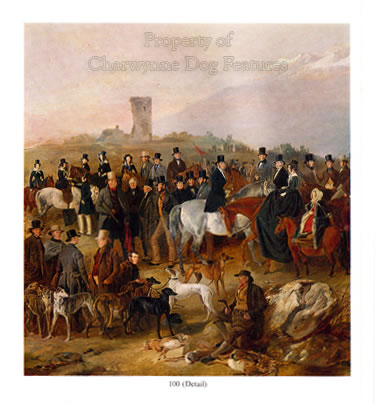
Sporting Salvation
As with a number of scenthound breeds, the future of the sighthound breeds is worryingly uncertain. Greyhounds have their racing side, Whippets have their admirable working Whippet club, lurchers have both a national body and a racing organisation, Afghan Hounds have their racing set-up – with other breeds encouraged to go along too but the loss of the coursing clubs leaves a big hole. No one body is caring for the sporting future of the sighthound. The kennel clubs of the world are not established to do this and could end up being the ‘Avon Ladies’ of the dog world, concerned only with cosmetic appeal, more focussed on presentation than performance. Their inability to understand the origins of the sighthound breeds illustrates their lack of real appreciation. In just one national kennel club’s official publication, the Ibizan Hound’s history is ‘traceable back to approximately 3400BC, with the glory that was ancient Egypt the most fitting setting for this regal hound, which was owned and hunted by the Pharaohs’; the Pharaoh Hound is ‘considered one of the oldest domesticated dogs in recorded history, tracing his lineage to roughly 3000BC. Fortunately, the history of Egyptian civilization was well documented and preserved through paintings and hieroglyphics and from these we learn that this unique dog…’ and the Saluki is described as ‘The Royal Dog of Egypt…a distinct breed and type as long ago as 329BC when Alexander the Great invaded India.’ What do they think went before? How can they ignore the Sumerians and not mention the Hyksos? The ancient Egyptians may have had the artefacts but the steppe nomads had the dogs! I shudder to think how they would have covered, say, a discovery of carvings at Stonehenge of dogs like the bat-eared purely British-blooded lurchers illustrated here! Sporting dogs, sighthounds especially, whatever their provenance, are easily lost to us once their founding function is removed; the survival of pedigree breeds by itself is only half the answer.
Breed Care
I believe that it is entirely fair to state that most breed clubs exist to serve the exhibition side of the breed’s affairs. But to care comprehensively for a breed, especially a sporting one and a sighthound one in particular, there is a distinct need for each breed club to feature: an archivist – who really must know the difference between a Tesem and a Tasy; a health watch scheme – which at long last the Kennel Club is urging; a proactive rescue system; a consultant morphologist – who really knows what the breed should look like and is guided by the KC’s commendable ‘fit-for-function’ campaign; and last but far from least, a sporting wing, running lure-racing, speed-racing – rather as the admirable Afghan Hound people do and any other physical activity for these remarkable hounds. From such a structure would come a renewed appreciation of what these dogs are for, where they came from, what they should look like and how to promote their well-being. These breeds must be conserved as hunting dogs.
Unwise Policy
In his book Medieval Hunting, Sutton Publishing Ltd., 2003, Richard Almond writes: “Man needs to hunt to release the pressures of being human, to appreciate the countryside, the seasons, to be aware of the beauty and brevity of life, and the inevitability and sadness of death…We are the inheritors of hunter-gatherers from not so long ago and the streams of consciousness of our ancient ancestors still runs deep and powerful.” When the next sizeable meteorite hits Mother Earth, as it surely will, who will be more likely to survive, the simple hunter with his efficient hunting dogs or a city dwelling merchant banker? When a distinguished diplomat and Saluki breeder is prevented from importing desert Salukis from the sheikhs by our Kennel Club because their pure breeding is in question we have clearly lost our way. When Bloodhound fanciers object to hounds from the packs being registered as Bloodhounds with the KC because their pure breeding is disputed, we have, in the modern idiom, lost the plot.
Community Event
It is so often overlooked by scholars that hunting in medieval times was very much a community event; the tenantry and those living in the countryside all took part in the chase. The poet Wordsworth picked this up in his words:
“Up, Timothy, up with your staff and away!
Not a soul in the village this morning will stay;
The hare has just started from Hamilton’s grounds,
And Skiddaw is glad with the cry of the hounds.”
There has long been a democratic basis to the hunting field that overcomes the different levels of class and social position, valuing instead capability and prowess. Hunting in the Middle Ages was much more inclusive, embracing every stratum of society and filling a larger social need than some historians will admit. As Henry Savage pointed out in his contribution to Speculum in 1933: “The hound of the middle ages was for use. It would have been strange for the medieval ‘venator’ to have thought of wolf-hounds without thinking of wolves, of deerhounds without thinking of deer. Our fathers protected the game to hunt it; we do not protect it, and are reduced to the necessity of pursuing anise-seed bags! If we are coming to a realization of the importance of conservation, we are only finding out what our fathers knew.” Moral vanity and the dislike of the chase by academics often ignores not just social history but what courses through our primaeval veins.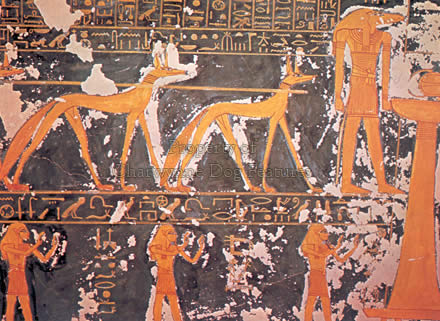
Loss of Working Anatomy
The handlers of sighthounds at Crufts are unlikely to know of the medieval ‘fewterers’ who held the sighthounds in the chase or the criteria they worked to. The hound judges at Crufts in 2008 made these comments on the hounds before them: Afghan Hounds; '...the breed has been getting further away from its origins and although there are many glamorous coated hounds there are fewer and fewer that display the true essence of the breed...' and ‘...he is a hunting hound not a dressed up puppet'. Borzoi; 'The Borzoi has to be able to chase and hold down a large formidable animal, could yours?' Pharaoh Hounds; 'This is a running hound and I was disappointed to find only a handful of dogs who were well muscled and fit...' What were those like which didn't qualify for Crufts! It is foolish to leave a sighthound breed entirely in the hands of its show ring fraternity. Most of the latter would welcome the involvement of and advice from those who use their hounds. The future of these outstanding hounds is threatened as never before; it will take both vision and dedication to retain them as true sporting hounds still able to carry out their historic role. I trust this book will contribute to securing their sporting future.
“In the world of dogs the sighthounds certainly constitute the most striking illustration of the adage ‘Beauty is born of the adaptation to function’. Today most are no longer utilized hunting by sight, a type of hunt forbidden almost everywhere or supplanted by the gun.”
Chiens de France No 9, 1994.
“Greyhounds love to run. Anyone who has spent any time around them knows that to be true. There is no need to prod, urge – or – God forbid – whip Greyhounds into action. Running is what Greyhounds were created for – both psychologically and physiologically. Greyhounds need to run as much as other breeds may need to herd or retrieve.”
The Reign of the Greyhound by Cynthia A Branigan, Howell House Books, 2004.